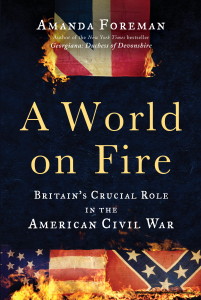A World on Fire by Amanda Foreman
 Winner of the Fletcher Pratt Award for Civil War History
Winner of the Fletcher Pratt Award for Civil War History
Finalist for the National Book Critics Circle Award
The New York Times Top Ten Books of 2011
Named one of the Best Books of the Year by The Washington Post, The New Yorker, Chicago Tribune, The Economist, Nancy Pearl, NPR, Bloomberg.com, Library Journal, and Publishers Weekly
Though with the North we sympathize
It must not be forgotten
That with the South we’ve stronger ties
Which are composed of cotton
Punch, 30 March, 1861
It is said that the closeness of siblings can be measured by the intensity of their fights. During the first one hundred years, Britain and the US were almost always arguing about something. Trade, maritime rights, and boundary disputes were the chief tinderlights; a spark from each had the capacity to send troops running to the barricades. Much good such martial spirits did for the belligerents. The war of 1812 ended ignominiously for both sides: the British Army suffered a stunning defeat at New Orleans, but not before it had seized Washington and set fire to the White House.
American anglophobia, already high, increased after 1812. It was positively unhealthy to be suspected of pro-British leanings. Every decade saw some fresh dispute. During the 1840s the quarrel centered on territory, in the 50s a friendly discussion over colonial ambitions in Central America turned into sour recriminations. Yet the two countries were each other’s best customers.
Southern cotton and Northern wheat fired up British factories and fed her workers. In return, manufactured goods and financial investment poured in to a hungry economy that was increasing faster than its population. (Between 1840 and 1860 America doubled from seventeen to thirty-two million.) The South grew richer and more genteel, while the North grew bigger and more powerful as artisans turned into workers, and entrepreneurs became bankers or industrialists. A vast network of railroads, partly financed by British capital, connected the North in a lattice of commerce. By 1860 an English oak dining table could be unloaded in New York on Monday and set for lunch in Chicago on Wednesday.
“History as a Cecil B. DeMille epic…One puts down A World on Fire with a sense of awe.” —The Boston Globe
“Thrilling narrative on a grand scale.” —History Today
“[A] remarkable book…an extraordinary cast.” — The New York Times Book Review
“[A] magisterial history.” —Newsweek
The New Yorker – 1 August 2011
“Over There” by Hendrik Hertzberg
Amanda Foreman’s “A World on Fire: Britain’s Crucial Role in the American Civil War” (Random House; $35) broadens the scope. Her story is more than an eye-opening corrective to American insularity. It is an immensely ambitious and immensely accomplished—and just plain immense—work of narrative art. At a third of a million words sprawled over nearly a thousand pages, “A World on Fire” is not far south of “War and Peace.” Yet the pages fly like the wind—like “Gone with the Wind”—because there’s so much life, so much action, and so many vivid people in them.
The Wall Street Journal – 25 June 2011
“When Cotton Wasn’t King” by Michael Burlingame
Amanda Foreman’s well-researched and highly readable “A World on Fire: Britain’s Crucial Role in the American Civil War” examines why the British government never did recognize the Confederacy. Ms. Foreman, the author of the best-selling biography “Georgiana, Duchess of Devonshire” (1999), is such an engaging writer that readers may find this 958-page volume too short. She supplements the traditional scholarly approach to British-American relations with an array of testimony from dozens of British witnesses to and participants in the Civil War. Their diaries, letters, reminiscences and newspaper reports provide insights into the war that differ from similar accounts by Americans, who perforce could not achieve the detached perspective of foreigners.
Guardian – 27 November 2010
“A World on Fire: An Epic History of Two Nations Divided by Amanda Foreman“” by Jay Parini
Amanda Foreman leapt into public view with her Whitbread-prizewinning portrait of Georgiana, the Duchess of Devonshire, in 1999, proving herself a storyteller of lavish gifts, a writer with an eye for the telling biographical detail who could also portray society at large – in that case the world of late-18th-century aristocrats in Britain and France. More than a decade later, she has delivered a massive work of considerable artistry, which tells the complex and riveting tale of British involvement in the American civil war.
More reviews here.
Virtual Book Signing – 2 November 2012
Abraham Lincoln Book Shop – Chicago, IL
Host Daniel Weinberg speaks to Amanda Foreman about her book A World on Fire.
The New York Historical Society – 8 November 2011
The Civil War: Great Britain’s Role
Ohio University – 31 January 2012
The George Washington Forum on American Ideas, Politics, and Institutions
Amanda Foreman speaks to an audience at Ohio University about her inspiration for writing A World on Fire.
C-Span – 15 July 2011
BookTV: After Words
Amanda Foreman discusses her book A World on Fire with Pulitzer Prize-winning historian Eric Foner.
CBS Boston – 8 July 2011
NightSide: Amanda Foreman, Author of “A World On Fire” Discusses The American Civil War
The Oldie – 7 June 2011
Oldie Literary Lunch
Amanda Foreman speaks to an audience of The Oldie magazine readers about A World on Fire and the discovery that led her to the subject while she was researching for Georgiana, Duchess of Devonshire.
C-Span – 26 March 2011
The Lincoln Conference, Washington DC
Britain’s Response to the Emancipation Proclamation
Video: http://www.c-span.org/video/?298687-2/britains-response-emancipation-proclamation
5 x 15 – 18 April 2011
Amanda Foreman @ 5 x 15





